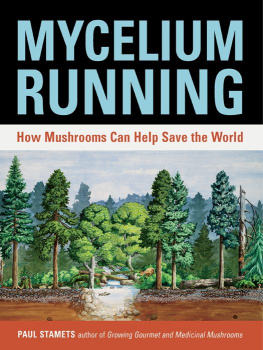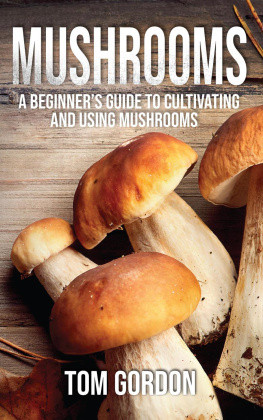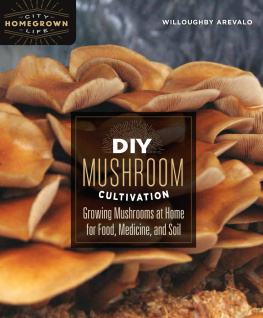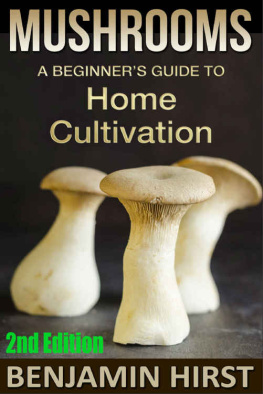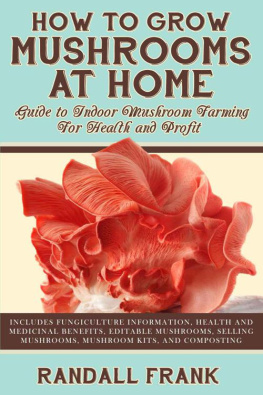
Copyright 2005 by Paul Stamets
Front cover illustration 2005 by Ann Gunter
All rights reserved. Published in the United States by Ten Speed Press, an imprint of the Crown Publishing Group, a division of Random House, Inc., New York.
www.crownpublishing.com
www.tenspeed.com
Ten Speed Press and the Ten Speed Press colophon are registered trademarks of Random House, Inc.
Library of Congress Cataloging-in-Publication Data
Stamets, Paul.
Mycelium running : how mushrooms can help save the world / Paul Stamets.
p. cm.
Includes bibliographical references and index.
1. Mycelium. 2. Mushroom culture. 3. FungiEcology. I. Title.
QK601.S73 2005
579.5163dc22 2005015898
eISBN: 978-1-58008-579-3
Cover design by Betsy Stromberg and Andrew Lenzer
Text design by Betsy Stromberg
The information in this book is accurate to the best of the authors knowledge. However, neither the author nor the publisher can accept any responsibility for mistakes in identification or idiosyncratic reactions to mushrooms; people who eat mushrooms do so at their own risk. This material is intended for educational purposes only; it is advisable to seek the advice of a licensed, professional health-care provider for any condition that may require medical attention.
v3.1
Dedicated to Dusty

Mushroomsignored by many, reviled by somemay turn out to be important keys to both human health and planetary health. Their indispensable role in recycling organic matter, especially in forests, has long been known. But how many people realize that trees and other green plants could not grow and reach maturity without symbiotic associations with mushrooms, at least with mycelium, the network of fungal threads in soil that act as interfaces between plant roots and nutrients?
A mushroom is the reproductive structure or fruiting body of mycelium. Mycelium runs through our world, performing many other feats as well, but it is hidden and inconspicuous-a strange life form that has not attracted the same scientific attention as micro-organisms or plants or animals. Even conventional mycologists hardly recognize its larger implications and possibilities.
Paul Stamets has never been a conventional thinker. I have known him for 25 years, and during that time, I have been repeatedly impressed by his insights into the interdependence of human beings and nature, his enthusiasm for harnessing and directing biological energies toward higher purposes, and his talent for thinking in novel and inventive ways. He has always looked at mushrooms from unique perspectives and as a result has made remarkable discoveries about them.
When we first met, I was questioning why Western medicine had never looked to mushrooms as sources of new therapeutic agents, given their prominence in the traditional pharmacopeias of China, Japan, and Korea. Paul took that question and ran with it, focusing on the natural competition that exists in soil between mycelium and bacteria. Fungi have evolved novel chemical defenses, a range of antibiotics that are often active against not only bacteria but also viruses and other infectious agents that cause disease in humans. One of the Big Ideas in this book is that fungi, especially fungi from old-growth forests, may be sources of new medicines that are active against a range of germs, including HIV/AIDS and the causative agents of smallpox and anthrax, potential bioterrorist threats.
Another of Pauls Big Ideas is that mycelium can be selected and trained to break down toxic waste, reducing it to harmless metabolites. He calls this strategy mycoremediation and has demonstrated its practicality in cleaning up oil spills. He suggests that our mushroom allies may even be able to detoxify chemical warfare agents.
This is one facet of a larger strategy that Paul calls mycorestoration, the use of fungi to improve the health of the environment: by filtering water, helping trees to grow in forests and plants to grow in gardens, and by controlling insect pests. The last possibility is especially noteworthy because it has the potential to neutralize pests like termites and fire ants by means that are completely nontoxic to human beings. Paul Stamets holds a number of patents in these areas, and I look forward to seeing his inventions put to use.
As a physician and practitioner of integrative medicine, I find this book exciting and optimistic because it suggests new, nonharmful possibilities for solving serious problems that affect our health and the health of our environment. Paul Stamets has come up with those possibilities by observing an area of the natural world most of us have ignored. He has directed his attention to mushrooms and mycelium and has used his unique intelligence and intuition to make discoveries of great practical import. I think you will find it hard not to share the enthusiasm and passion he brings to these pages.
Cortes Island, British Columbia
June 2005
A NDREW W EIL , MD
For 30 years, I have engaged fungi, or perhaps they have engaged me, in a mission to promote the benefits of mushrooms. My previous books Growing Gourmet and Medicinal Mushrooms (2000a) and The Mushroom Cultivator, coauthored with Jeff Chilton (1983), delve into the methods of cultivating mushrooms. This new book is designed to show readers how to grow mushrooms in gardens, yards, and woods for the purpose of reaping both personal and planetary rewards. As you will discover, mushrooms help us reconnect to nature in profound ways. Mushrooms, mysterious and once feared, can be powerful allies for protecting the planet from the ecological injury we inflict.
More specifically, this book focuses on healing the planet using mycelial membranes, also known as mycelium, a fungal network of threadlike cells; it is a mycological manual for rescuing ecosystems. Engaging mycelium for healing habitats is what I call mycorestoration. The umbrella concept of mycorestoration includes the selective use of fungi for mycofiltration, mycoforestry, mycoremediation, and mycopesticides. Mycofiltration uses mycelium to catch and reduce silt and catch upstream contaminants. Mycoforestry uses mycelium and mushrooms to enhance forest health. Mycoremediation neutralizes toxins. Mycopesticides refers to the use of fungi to help influence and control pest populations. This quartet of strategies can be used to improve soil health, support diverse food chains, and increase sustainability in the biosphere.
This book is written for a readership as diverse as the fungal community. For readers devoted to recycling, organic cultivation, habitat restoration, or applied mycology, I hope this book will be as useful as it is revolutionary. If you are a landscaper, bioremediator, ecoforester, sustainable-village planner, physician, scientist, futurist, or anyone who is passionately bemushroomed, I hope this book enriches your life and that you will pass on the love of mushrooms to future generations. And even if you have never walked through an old-growth forest, cultured fungus in a petri dish, relished a fresh-picked matsutake grilled over an open fire, or taken a mushroom-based medicine, I hope you will find this bookand my pragmatic environmental philosophy described hereininformative and inspiring. I contend that the planets health actually depends on our respect for fungi. This book will show how you can help save the world using mushrooms.
Next page
